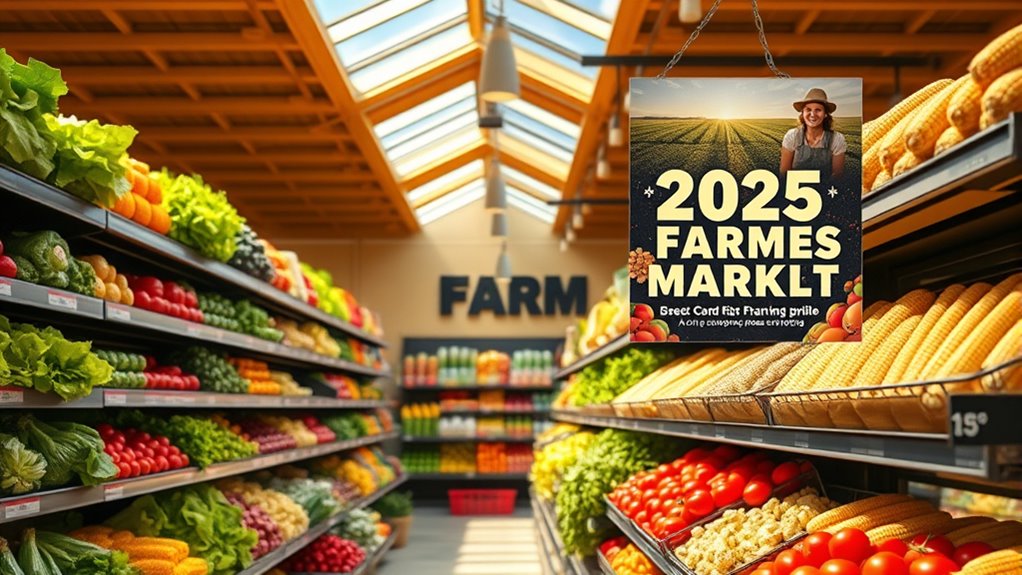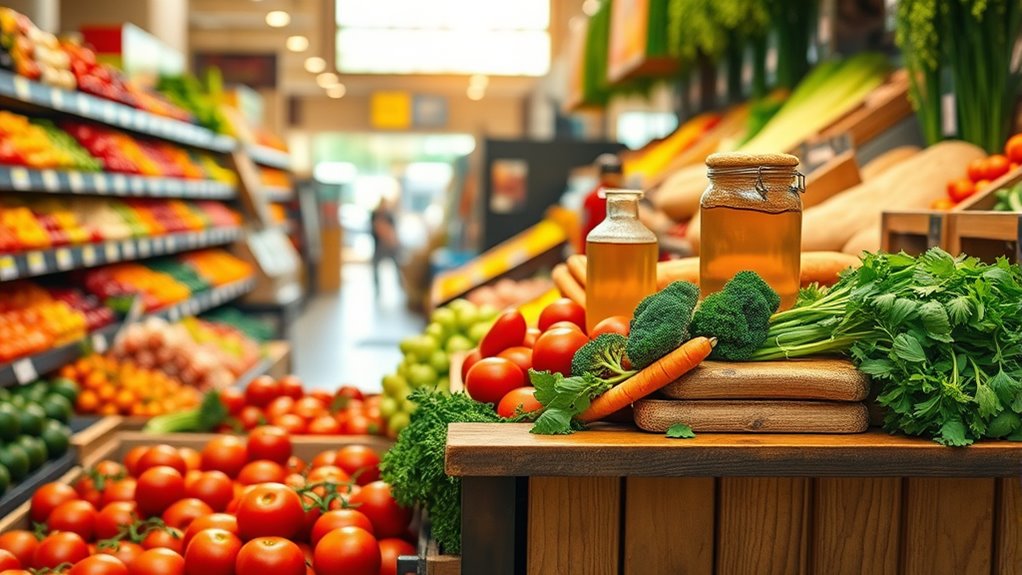The 2025 Farm Bill will impact your grocery prices by shaping crop subsidies, which influence the cost and availability of staples like bread, cereals, and snacks. Changes in subsidies can lead to lower or higher crop prices, affecting supply and grocery store shelves. Plus, adjustments to food assistance programs may impact what you can afford. To see how these policies might affect your shopping cart and explore the details, keep going for a closer look.
Key Takeaways
- Changes in crop subsidies can lower or raise prices of staple ingredients like corn, wheat, and soy, affecting grocery costs.
- Adjustments to the Farm Bill may impact food supply stability and availability of essential products in stores.
- Expanding food assistance programs can make groceries more affordable for low-income households.
- Redirecting subsidies toward diversified and sustainable farming influences crop prices and product variety.
- Overall, Farm Bill policies directly shape grocery prices and consumer affordability through supply chain and market dynamics.

The upcoming Farm Bill 2025 is poised to substantially influence grocery prices you pay every day. This legislation sets the stage for how farmers grow crops, which directly impacts the cost and availability of the food on your shelves. One of the key components you should watch is crop subsidies—government payments to farmers designed to stabilize crop prices and encourage production. When crop subsidies increase, farmers often grow more staple crops like corn, soy, and wheat, which can lead to lower prices for these ingredients. Conversely, if subsidies decline or shift focus, shortages or higher costs could ripple through the supply chain, ultimately raising grocery prices. Knowing how these subsidies are structured helps you understand potential changes in the prices of everyday products, from bread to breakfast cereals.
Beyond crop subsidies, the Farm Bill also influences food assistance programs, which play a significant role in shaping the accessibility and affordability of groceries for millions of Americans. If the new bill expands or enhances food assistance initiatives like SNAP (Supplemental Nutrition Assistance Program), more families might be able to afford nutritious foods, potentially affecting demand and prices. On the other hand, cuts or restrictions could make it harder for low-income households to access healthy options, which might shift purchasing patterns and impact grocery store inventories. These changes can ripple through the market, influencing what’s available and at what cost.
The Farm Bill’s decisions on crop subsidies and food assistance are interconnected. For instance, boosting crop subsidies for certain commodities could lead to an oversupply, which might lower prices temporarily but also risk market distortions. Conversely, reducing subsidies or redirecting funds toward programs that support diversified farming could lead to higher prices for some products but foster a more resilient and sustainable food system. Your grocery bill will feel these shifts, especially if certain crops become more or less affordable to produce. Additionally, the way high-quality equipment is utilized in farming can influence overall productivity and crop yields, further impacting prices. A better understanding of agricultural technology helps illustrate the potential for increased efficiency and cost savings in farming practices.
As a consumer, it’s essential to stay informed about these policy changes. The Farm Bill doesn’t just affect farmers; it shapes the entire food supply chain. If crop subsidies favor certain crops, your favorite products might see price fluctuations. If food assistance programs expand, it could mean more affordable options for you and your community. Understanding these elements helps you anticipate how upcoming legislative decisions might impact your grocery shopping experience, making you a more informed and proactive shopper.
Frequently Asked Questions
How Will the Farm Bill Impact Organic Produce Pricing?
The farm bill could influence organic premiums and produce costs, affecting what you pay at the store. If the bill increases support for organic farming, expect prices to stabilize or drop, making organic produce more affordable. Conversely, if funding shifts away from organic programs, premiums might rise, raising your grocery bills. Overall, the bill’s policies will shape the affordability of organic produce and how much you pay for healthier options.
Will New Subsidies Benefit Small or Large Farmers More?
You might wonder if new subsidies favor small farmers or large ones. The goal is to boost support for small farmers, so subsidy benefits are designed to reach them more directly. This means you could see more diverse, local produce on your shelves, and small farmers gain stability. While big farms may still access some benefits, the focus is on empowering small farmers to thrive and offer fresh options to your grocery cart.
Are There Provisions to Reduce Food Waste in the Bill?
Imagine a bustling grocery store where food waste is dramatically reduced—this scene reflects the bill provisions aimed at tackling food waste. The 2025 Farm Bill includes measures like better supply chain management and incentives for food recovery programs. These provisions help cut down waste, ensuring more food reaches those in need. By addressing food waste, the bill promotes sustainability and could even help lower prices for consumers like you.
How Does the Bill Address Climate Change and Agriculture?
You’ll see the bill promotes climate-smart practices, supporting sustainable farming and reducing environmental impact. It encourages farmers to adopt renewable energy sources and eco-friendly methods, helping combat climate change. By investing in these initiatives, the bill aims to make agriculture more resilient and sustainable. You benefit from a healthier environment and potentially lower costs, as sustainable practices can lead to more stable food prices and improved food security.
Will Consumer Access to Affordable Groceries Improve Under the Bill?
You might see improvements in food affordability and grocery accessibility with the new bill. It aims to support local farmers and boost supply chains, which can lower prices and increase availability. By investing in rural communities and promoting sustainable practices, it helps make groceries more affordable for consumers. Overall, these efforts are designed to guarantee you have better access to affordable, nutritious food, easing the cost burden on your household.
Conclusion
As you consider the Farm Bill 2025, remember it could influence your grocery prices more than you think. For instance, changes aim to boost crop yields and reduce costs, potentially lowering prices at your checkout. An interesting stat shows that agriculture policies can impact food costs by up to 20%. Staying informed helps you understand how these decisions might save you money or affect your shopping habits in the coming years.
Amina brings over a decade of journalism experience to her role as Editor-in-Chief. Under her leadership, Exquisite Post has flourished, maintaining the highest standards of integrity and excellence. Amina’s commitment to truth and her visionary approach guide the editorial team in producing impactful news stories that resonate with our audience.










